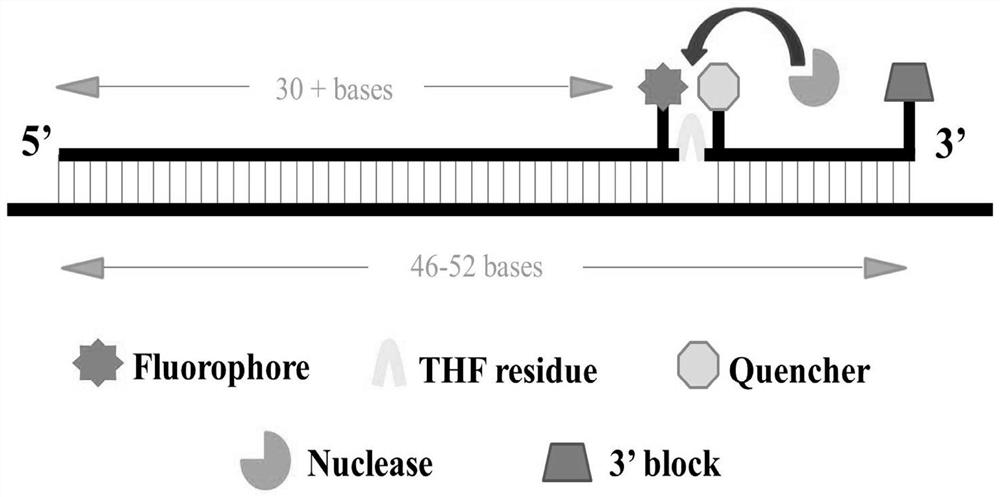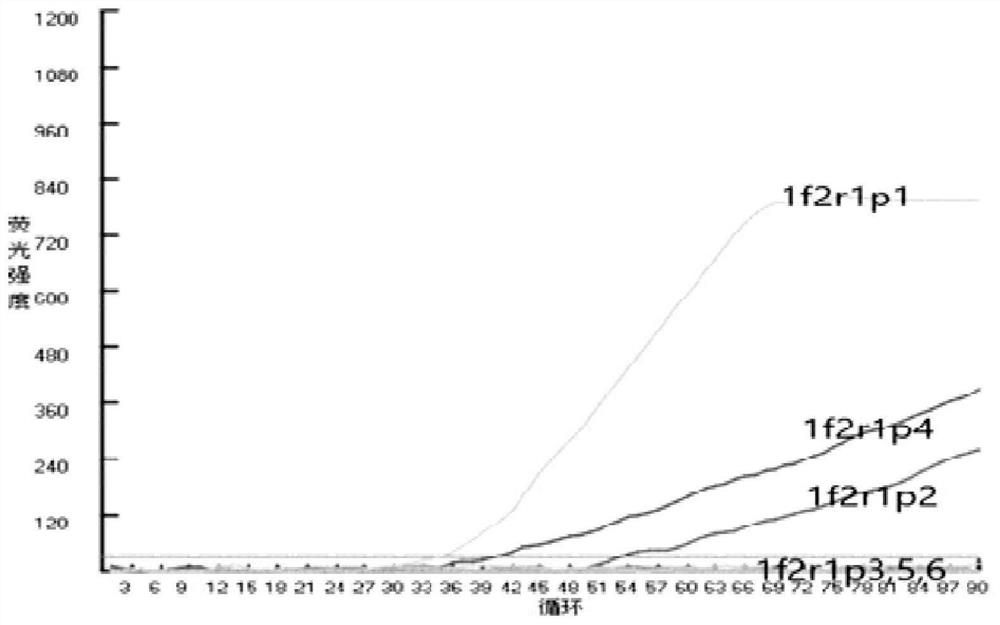Primer probe set and detection method for detecting severe fever with thrombocytopeniasyndrome virus by real-time fluorescence RNA RT-RPA (reverse transcription-recombinase polymerase amplification)
A real-time fluorescence and primer-probe technology, applied in biochemical equipment and methods, DNA/RNA fragments, recombinant DNA technology, etc., can solve problems such as unsuitable for on-site emergency detection tasks, complex operation, large volume, etc., to achieve efficient real-time Fluorescent RNA is rapidly amplified at constant temperature, easy to operate, and has broad application prospects
- Summary
- Abstract
- Description
- Claims
- Application Information
AI Technical Summary
Problems solved by technology
Method used
Image
Examples
Embodiment 1
[0043] Example 1 Preparation of In vitro Transcribed RNA of Fever with Thrombocytopenia Syndrome Virus NP Gene
[0044] In this example, the in vitro transcribed RNA of the NP gene of fever with thrombocytopenia syndrome virus was prepared by using the in vitro transcription method, so as to provide a positive RNA template for subsequent detection experiments.
[0045] 1. PCR amplification of NP gene containing T7 promoter
[0046] The PCR method is used to introduce the T7 promoter into the upstream of the positive-strand reading frame and the downstream of the negative-strand reading frame of the fever with thrombocytopenia syndrome virus, so as to obtain RNA consistent with the viral genome sequence after in vitro transcription. Using the cDNA synthesized by reverse transcription of viral RNA as a template, use the FastStart High Fidelity PCR system to prepare the following PCR reaction system:
[0047]
[0048] Upstream primer (SEQ ID NO.5): 5'-TTGTGAGCGGATAACAATTCCC-3...
Embodiment 2
[0077] Example 2 Design of primers and probes suitable for real-time fluorescent RNA constant temperature rapid amplification
[0078] Through the sequence comparison of the NP gene of fever with thrombocytopenia syndrome virus, the conserved region was found, and primers and probes suitable for real-time fluorescent RNA constant temperature and rapid amplification technology were designed for the conserved region.
[0079] The general principles of primer and probe design for RNA isothermal rapid amplification are as follows:
[0080] (1) The length of the probe is generally between 46-52.
[0081] (2) The probe generally includes a fluorescent group, a quencher group, tetrahydrofuran (THF) and a block at the 3' end.
[0082] (3) The 5' end of THF needs to have at least 30 bases, and the 3' end generally needs to have 15 bases. THF is located between the fluorescent group and the quencher group, generally between the fluorescent group and the quencher group 2-4 bases apart....
Embodiment 3
[0121] Example 3 Method for detecting fever with thrombocytopenia syndrome virus by constant temperature and rapid amplification of real-time fluorescent RNA
[0122] Using the primers and probes shown in Table 7, use the RNA Constant Temperature Rapid Amplification Kit (Anpu Future, fluorescent type) to perform real-time fluorescent RNA constant temperature rapid amplification. The specific method is as follows:
[0123] Add 29.4 μl of rehydration buffer (Buffer A), 2 μl of upstream and downstream primers (10 μM), 0.6 μl of probe (10 μM), 0.5 μl of 40 U / μl RNase inhibitor and ddH 2 O 7.5 μl was mixed to obtain 42 μl of working buffer, and then 5 μl of the sample RNA to be tested was added as a template to mix with the above working buffer, and added to the enzyme amplification eight-tube tube equipped with a dry powdered enzyme system, and the Dissolve and mix well, and finally add 3 μl magnesium acetate solution (Buffer B) to the cap of the eight-tube tube, cover the cap car...
PUM
 Login to View More
Login to View More Abstract
Description
Claims
Application Information
 Login to View More
Login to View More - R&D
- Intellectual Property
- Life Sciences
- Materials
- Tech Scout
- Unparalleled Data Quality
- Higher Quality Content
- 60% Fewer Hallucinations
Browse by: Latest US Patents, China's latest patents, Technical Efficacy Thesaurus, Application Domain, Technology Topic, Popular Technical Reports.
© 2025 PatSnap. All rights reserved.Legal|Privacy policy|Modern Slavery Act Transparency Statement|Sitemap|About US| Contact US: help@patsnap.com



